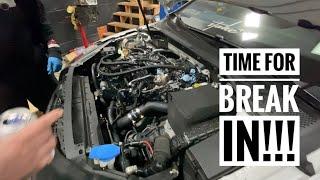Space Propulsion: Interplanetary Inertial Engine = 2g Thrust. (Glen A. Robertson, Technical Advisor)
Description
Electric In-Space propulsion uses no fuel. Thrust is generated as impulses where in space, momentum is additive. Rotary motion is converted into bi-linear oscillation of a carriage then its momentum rectified: The carriage is shifted forward during low inertia, so momentum used to oscillate the carriage forward is conserved to be used later in the cycle. Reverse carriage oscillations are deflected. This creates only a pulsed demand on the electric power supply – thus too fulfilling the law of Conservation of Energy. Newton’s third law of motion is upheld because action and reaction are not simultaneous events, so in this engine, the inertial delay occurs at post carriage shift during part of the rotors’ orbit – when centrifugal force emerges: The centripetal force of the rotors are cyclically nullified by the shift resulting in surges of centrifugal force. (Patent Pending)
THE PENDULUM TEST
There are various ways to test for thrust from a closed propulsion system – all have disadvantages. But only the pendulum test allows for the drive to be observed from one vantage point with the lowest intractance. Since 1993, I have experimented with various pendulum configurations on nine different inertial drives that I’ve designed and built. So, I would like to clear up a few common misconceptions on how impulse drives react with a hanging pendulum. First, let’s review how this test came to be so recognized as a means to measure linear force from such drives.
A Brief History of Swing
“The first known use of a pendulum to test thrust was done in 1915 by Robert Goddard using a ballistic pendulum. Benjamin Thompson a century earlier determined the speed of a projectile when it was fired into a heavy plate suspended by a pendulum to calculate the speed of the projectile. Goddard modified this by attaching a rocket to a heavy pendulum and then igniting it to observe how high the pendulum rose. A better procedure was soon devised in which the force exerted on a test stand was measured continuously by observing the compression of a spring, then later, by a strain gauge attached to the test stand.” (Raymond Friedman, A History of Jet Propulsion, Including Rockets © 2010)
The Turtle is in The Race
Once again, the ballistic pendulum test must be modified to accurately test impulse drives. Since the forces involved here are generated in cyclic manner, the test must be viewed like the earliest version as it was used to test cannons. A continuous deflection of the pendulum from zenith will not result with these drives as can be expected when testing jets or rockets.
Our drives operate at around 4 Hz and a continuous thrust is not needed in space when a series of impulses will do. A common misconception about the pendulum test is that the drive is supposed to deflect the pendulum far to one side and hold steady. But if the machine could do that, then it could levitate. Levitation is not required to propel us in space. “Impulse drives” are just that – machines that produce a pulse. A pulse is generated and the system is propelled, and then (in space) it coasts until the next impulse which is additive.
Hang ‘Em Low
The real purpose of the pendulum test for inertial propulsion is to show bias: The drive has to work against gravity and recover after each impulse because it is hanging in a gravitational field swinging the pendulum in an upward arc against gravity. Remember, we are still within a gravity field. Amazingly, the length of the lines has little effect on the results. But what the lines are made of does: The heavier the lines, the less stray line oscillation. So which pendulum test is best and true?
Fighting Gravity
Many physicists advocate a 4-point pendulum test where the lines terminate above at four separate places. However, this forces the drive to have to lift itself in order to deflect from zenith – if it could do that, then it could levitate – we are testing for thrust generated horizontally, not vertically.
Playground Chronicles
Remember the rush of the playground swing? A 2-point zenith termination (at the top of the swing set) allows for the least amount of resistance needed to get yourself high in the air. But in order to really get ourselves up there, we had to kick-up our legs in an upward arc. Kicking our legs out parallel to the ground (as with a 4-point test) would hinder the swing: When testing for thrust from an In-Space drive, gravity must be neutralized. So, in the 2-point pendulum test we have discovered that by tilting the front of the engine 10 degrees upward while hanging on the pendulum (using light chains), gives us that arc needed to follow the swing of the lines with the least amount of gravitational resistance as can be seen from our accelerometer test results. The negative spikes and variance in the waveform can be resolved with better machining of the drive because like all my other drives, I hand built this machine.
See all our prototypes at www.InertialPropulsion.com











![[Space 2] Top 10 Shocking Facts About Space | Facts About of Space | Universe in Hindi | Fact Tour](https://no-mar.com/uploads/thumbs/21d7c85e7-1.jpg)









Comments